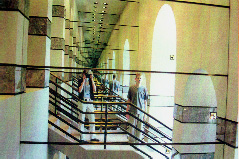
First Place - Natural Category
Infinite
Reflection
Elizabeth Gutting, John Burroughs School, 755 S.
Price Rd., St. Louis, MO 63124
Teacher: J. Mark Schober
Images
are formed in mirrors when light rays reflect off the polished surface. In
this photograph, the light rays bounce off one mirror and hit the opposite
mirror. The mirror behind my brother shows both his back and his face
because the light rays are bouncing between the mirrors. Each additional
reflection adds to the image distance, so the suggestive reflections
appear farther and farther away. This is also what creates the image of
the hallway that seems to keep going back. The reflections would go on
forever, but the images fade in the distance because the mirrors are not
perfect reflectors; they absorb and scatter some of the light that hits
them.
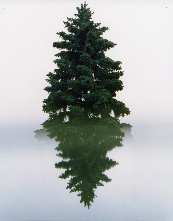
First Place - Contrived Category
Mirror
Against a Camera Lens
Stephanie Hill, Port Credit Secondary School,
70 Mineola Rd. E., Mississauga, ON L5G 2E5, CANADA Teacher: Alan
Hirsch
To shoot the photo, a small plane mirror was held almost
perpendicular (mirror side up) to the camera lens. The picture affords the
observer the illusion of looking across a very foggy, still lake at a tree
and its reflection in the water.

Refraction of Light
Melissa R. Ghrist, Oak Ridge H.S., 27330 Oak Ridge School Rd., Conroe, TX 77385
Teacher: Cathy Ezrailson
I took this picture of my cat through a large Ozarka water bottle. The cat is magnified because of the refraction of light through the plastic. When light travels in a vacuum, it travels at the speed of 3.00 x 108 m/s. When light travels through something else, such as plastic, it travels at a lower speed. This change in speed is responsible for the bending of light towards a normal line that is perpendicular at an interface. The curvature in the plastic water bottle caused a refraction of the light, making the image of the cat appear larger.

Optical Elements of Physics
Bobby Mantoni, Springbrook H.S., 201 Valleybrook Dr., Silver Spring, MD 20904
Teacher: Nazish Habib
The concentric rectangles of light were achieved by having a second rectangular mirror placed on the opposite row of lights, both following the perimeter of the plane mirror. The light emitted from the lights reflects off one mirror, then reflects off the second mirror, and then emerges through the center of the viewer's eye. The second element of optical physics is the circular rainbow surrounding the bright flash of light in the center. This rainbow was caused by the bright flash of light reflecting off the mirror and then being diffracted through the lenses in the camera.
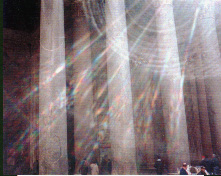
Dispersion, Refraction, and Thin Film Interference
Jason Evans, International Academy, 1020 E. Square Lake Rd., Bloomfield Hill, MI 48304
Teacher: David Lyons
As the sunlight went through the camera lens, it was refracted. As this light went back into the air towards the film, it was bent away from the normal, and, in doing so, was dispersed into colors similar to a prism. These colors appear as different colored packets of light that were printed onto the film. At some points, the sunlight reflected off the lens at an angle greater than the critical angle for total internal reflection, thus white spots appear. Finally, there appears to be a form of thin film interference creating "Newton's rings," which originate from the two elements of the main lens. The light that traverses through the lens is subject to this interference, which causes rings to appear in the upper right hand corner due to varying lengths for the transmitted and reflected rays.
unavailable for publication.
Reflections in a Glass Ball
Codi Williams, Oak Ridge H.S., 27330 Oak Ridge School Rd., Conroe, TX 77385
Teacher: Cathy Ezrailson
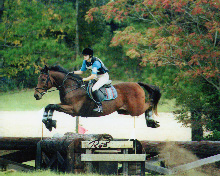
Anna Kathryn Jones, Jackson Preparatory School, P.O. Box 4940, Jackson, MS 39296
Teacher: Marsha Hobbs
This photograph demonstrates projectile motion in two dimensions, the X and the Y dimensions. The horse is at the highest point of his path across the jump; therefore, the velocity in the Y direction at this point is zero. The acceleration in the X direction remains zero throughout the path because no external forces are causing the horse to accelerate in the X direction. The horse's path follows a parabolic path across the jump.
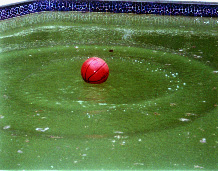
Wave Motion
Rebecca White, Falls Church H.S., 7521 Jaguar Trail, Falls Church, VA 22042
Teacher: Ben Allen
I threw a ball into the pool, and circular waves were formed and moved outward. These waves were moving with a velocity that was determinable. Each water particle oscillated around a point of equilibrium. The water waves were capable of moving over a large distance; however, the water itself had limited movement. Even though the wave was not matter, the wave pattern clearly traveled in matter. The waves contained oscillations that moved without carrying matter with them. In addition, the waves carried energy. The energy was given to the water wave by the basketball thrown into the water. The energy was then transported from the waves to the edge of the pool.
| 2000 AAPT Video
Contest Winners
Student Category |
|
Thanks Participants in the AAPT High School Physics Photo Contest gain experience, knowledge, and exposure. And what do they gain by winning? Thanks to Vernier Software & Technology, a leader in the production of quality sensors, interfaces, software, and lab books, student winners and their teachers receive money prizes, gift certificates, and plaques. Thanks Vernier. Visit Vernier on the Web at http://www.vernier.com/. |
Student winners
received: First Place - $100 check and plaque Second Place - $75 check and plaque Third Place - $50 check and plaque Honorable Mention - $25 check Teachers of winning students received: For each winning student (First, Second, Third) the teacher receives $100 Vernier Software gift certificate or a plaque with the student's name. For multiple winners the teacher can choose a combination of gift certificate and plaque. |